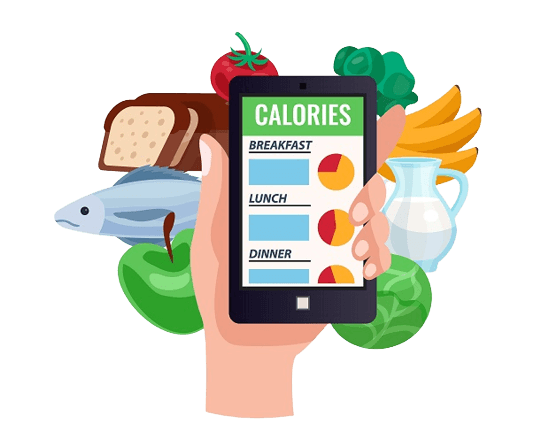Carb Cycling For Fat Loss
Introduction to Carb Cycling for Fat Loss
Carb cycling has been gaining popularity in recent years as an effective strategy for shedding those stubborn pounds and achieving optimal body composition. But what exactly is carb cycling? In simple terms, it refers to a dietary approach where you alternate between high-carbohydrate days and low-carbohydrate days. This method allows you to strategically manipulate your carbohydrate intake to optimize fat loss while still providing energy for workouts and maintaining muscle mass. Carb cycling works based on the premise that our bodies are highly adaptable organisms. When we consistently consume a high amount of carbohydrates, especially those from processed foods and sugary treats, our bodies become reliant on glucose as the primary fuel source. As a result, the excess glucose gets stored as fat, leading to weight gain. By implementing carb cycling, we disrupt this cycle by periodically reducing carbohydrate intake. This reduction forces our bodies to tap into stored fat for energy instead of relying solely on glucose. Additionally, carb cycling helps regulate insulin levels—a hormone responsible for controlling blood sugar levels—as prolonged high insulin levels can inhibit fat burning.
Definition of Carb Cycling
Carb cycling involves alternating between days of higher carbohydrate intake and days of lower carbohydrate intake throughout the week or in specific phases of a diet plan. On high carb days, you consume a surplus of carbohydrates (typically 2-3 grams per pound of body weight) to replenish glycogen stores and provide energy for intense workouts or physically demanding activities. On low carb days, you limit your carbohydrate intake (usually around 0.5-1 gram per pound of body weight) with the goal of maximizing fat burning. It's important to note that carb cycling is not about completely eliminating carbohydrates from your diet; rather, it's about strategically manipulating your macronutrient ratios based on your goals and activity level. It's a flexible approach that allows individuals to adapt the plan to their preferences and lifestyle while still achieving fat loss and improving overall body composition.
Explanation of how it promotes fat loss
Carb cycling promotes fat loss through several mechanisms. First, by periodically reducing carbohydrate intake, we force our bodies to tap into stored fat for fuel. When carbohydrates are limited, our bodies turn to alternative energy sources such as stored glycogen (in the liver and muscles) and eventually transition into a state called ketosis, where they rely on ketone bodies derived from fat metabolism. Furthermore, manipulating carbohydrate intake helps regulate insulin levels—a key player in fat metabolism. When we consume carbohydrates, especially those with a high glycemic index like refined sugars, our blood sugar levels spike rapidly. In response, the pancreas releases insulin to move glucose from the bloodstream into cells for energy or storage. However, chronically elevated insulin levels can hinder fat burning and promote fat storage. Carb cycling mitigates this issue by incorporating low carb days. On these days, insulin levels remain lower as carbohydrate intake is limited. This creates an environment conducive to mobilizing stored body fat for fuel. By alternating between high carb and low carb days strategically throughout the week or in specific phases of a diet plan, we optimize insulin sensitivity and promote efficient utilization of both dietary and stored fats. Carb cycling is an effective dietary approach that promotes fat loss by manipulating carbohydrate intake to optimize metabolic flexibility and enhance insulin sensitivity. By alternating between high carb days for energy replenishment and low carb days for maximizing fat burning mechanisms, individuals can achieve their weight loss goals while still enjoying the benefits of carbohydrates in their diet
Understanding Carbohydrates and their Role in the Body
Brief overview of carbohydrates as a macronutrient
Carbohydrates are one of the three main macronutrients, alongside proteins and fats. They are the body's primary source of energy, providing fuel for various bodily functions and physical activities. Unlike proteins and fats, which contain 4 calories per gram, carbohydrates provide 4 calories of energy per gram when digested. This makes them an essential component of a balanced diet.
Different types of carbohydrates (simple vs complex)
Not all carbohydrates are created equal. They can be classified into two main types: simple and complex carbohydrates. Simple carbohydrates include sugars found naturally in fruits (fructose) or dairy products (lactose), as well as refined sugars like table sugar or high-fructose corn syrup. These types of carbs are quickly broken down by the body, leading to a rapid spike in blood sugar levels. On the other hand, complex carbohydrates consist of starches and fiber found in foods such as whole grains, legumes, vegetables, and fruits. Complex carbs take longer to digest due to their more intricate molecular structure. This slower digestion results in a gradual release of glucose into the bloodstream, providing sustained energy over a more extended period.
How carbohydrates affect blood sugar levels
When we consume carbohydrates-rich foods, they are broken down into glucose during digestion and released into our bloodstream. This causes an increase in blood sugar levels known as glycemic response. Simple carbs typically have a higher glycemic index than complex carbs because they are rapidly absorbed by the body. The rate at which our blood glucose rises depends on various factors such as the type and quantity of carbs consumed, individual metabolism, and whether other nutrients like protein or fat were consumed alongside them. High-glycemic foods can cause a sharp spike in blood sugar levels, triggering a subsequent increase in insulin production from the pancreas to regulate glucose levels. Insulin helps transport glucose from the bloodstream into our cells, where it can be used for energy or stored as glycogen for later use. Monitoring blood sugar levels and managing carbohydrate intake is particularly crucial for individuals with conditions like diabetes or insulin resistance. By understanding the differences between simple and complex carbs and their impact on blood sugar, we can make informed choices about our food consumption to maintain stable energy levels and overall well-being.
The Science Behind Carb Cycling for Fat Loss
How Carb Cycling Manipulates Insulin Levels
Carb cycling, my friend, is not just another fad diet. It's a carefully crafted approach that plays with your insulin levels like a maestro conducting an orchestra. When you consume carbohydrates, they get broken down into glucose, which then enters your bloodstream. This triggers the release of insulin from your pancreas, the hormone responsible for shuttling glucose into your cells to be used as energy or stored as fat. Here's where carb cycling works its magic: on high carb days, you strategically increase your carbohydrate intake. This flood of glucose in your system prompts a surge in insulin production. The idea behind this is to create an optimal environment for muscle growth and replenish glycogen stores. On low carb days, however, you limit your carbohydrate intake to keep insulin levels in check and encourage fat burning.
Impact of Insulin on Fat Storage and Metabolism
Insulin is not just a humble hormone; it wields immense power over our body composition goals. When insulin levels are high (hello there, high-carb feast), fat burning takes a backseat as our body prefers to use readily available glucose for energy instead of tapping into those stubborn fat stores we desperately want to get rid of. But fear not! By alternating between high and low carb days during carb cycling, we manipulate our insulin response strategically. On low carb days when insulin levels are lower, our bodies shift gears and start relying more on fats for fuel instead of carbohydrates. This metabolic flexibility becomes key in torching that excess flab and unveiling the lean physique hiding underneath.
Benefits of Alternating High and Low Carb Days
Why settle for just one way when you can have the best of both worlds? That's precisely what alternating high and low carb days in carb cycling offers. By providing the body with periods of both high and low carbohydrate intake, we ensure that fat loss is maximized while still supporting our performance and recovery needs. On high carb days, you replenish your glycogen stores, enhancing your energy levels, and boosting athletic performance. This becomes especially crucial if you're engaging in intense physical activities or hitting the gym with vigor. On low carb days, your body becomes more efficient at utilizing fat for fuel, making it easier to shed those unwanted pounds. Additionally, this interplay between high and low carb days prevents your metabolism from hitting a plateau. Our bodies are intelligent machines that quickly adapt to changes in our diet. By constantly switching things up through carb cycling, we keep our metabolism guessing and firing on all cylinders. So my friend, if you're looking for a sustainable way to shed fat without sacrificing muscle mass or energy levels – carb cycling might just be the secret sauce you've been searching for! Note: The article has three additional sections remaining (IV - VIII). Please let me know if you would like me to continue writing those sections as well!
Implementing Carb Cycling: The Basics
Calculating daily calorie and macronutrient needs
When it comes to carb cycling, the first step is to determine your daily calorie and macronutrient needs. This will help you create a solid foundation for your diet plan. To calculate your daily calorie needs, you can use an online calculator or consult with a nutritionist. It's important to take into account factors such as age, gender, weight, height, and activity level. Once you have determined your daily calorie intake, you can then allocate the appropriate percentages for each macronutrient - carbohydrates, proteins, and fats. While individual requirements may vary based on personal goals and preferences, a common starting point is 40% carbs, 30% protein, and 30% fat.
Determining high and low carb days based on goals and activity level
The next step in implementing carb cycling is determining the frequency of high and low carb days based on your specific goals and activity level. High carb days are typically reserved for more intense workout days or when you need more energy for physical activities. If muscle gain or athletic performance is a priority for you, consider scheduling high carb days around your toughest workouts or training sessions. On these days, aim to consume around 50-60% of your total calories from carbohydrates. On the other hand, low carb days are ideal for promoting fat loss as they force the body to rely more on stored fat as an energy source. These days typically involve lower-intensity workouts or rest days. To determine how many high and low carb days to include in your cycle each week, consider factors such as your current body composition goals (fat loss vs muscle gain), overall caloric intake goals (deficit vs maintenance), and personal preferences. By strategically alternating between high and low carbohydrate intakes, you can optimize your body's ability to burn fat while still providing the necessary fuel for performance and recovery. Remember, the key to success in carb cycling lies in finding the right balance that suits your individual needs and preferences.
High Carb Days: Fueling Performance and Muscle Growth
Importance of glycogen replenishment on high carb days
When it comes to carb cycling for fat loss, high carb days play a crucial role in fueling your performance and supporting muscle growth. One of the main reasons why high carb days are so important is because they help replenish glycogen stores in your muscles. Glycogen is essentially stored glucose in your body, and it serves as the primary source of energy during intense workouts. During high intensity exercise, such as weightlifting or HIIT workouts, your muscles rely heavily on glycogen for fuel. When glycogen stores are depleted, you may experience a significant drop in energy levels and reduced workout performance. This can hinder your progress in the gym and make it harder to build lean muscle mass. By incorporating high carb days into your carb cycling routine, you ensure that your glycogen stores are fully replenished before hitting the gym. This allows you to perform at your best, lift heavier weights, push through challenging sets, and maximize muscle growth potential.
Ideal food choices for maximizing energy levels during workouts
On high carb days, it's important to choose the right foods that will provide sustained energy throughout your workouts. Opting for complex carbohydrates that are rich in fiber will help release glucose into your bloodstream more gradually, providing a steady supply of fuel. Some ideal food choices for maximizing energy levels during workouts include whole grains like quinoa or brown rice, sweet potatoes, oatmeal, and fruits such as bananas or berries. These foods are not only packed with complex carbs but also contain valuable vitamins and minerals that support overall health. Additionally, pairing carbohydrates with a good source of protein can further enhance performance by promoting muscle protein synthesis. This can be achieved by combining foods like grilled chicken with brown rice or having Greek yogurt topped with fresh fruits. The combination of carbohydrates and protein helps to maintain steady blood sugar levels and supports muscle recovery and growth. It's also essential to consider the timing of your high carb meals before a workout. Aim to consume your high carb meal 1-2 hours before hitting the gym. This allows sufficient time for digestion, ensuring that the glucose from carbohydrates is readily available as fuel during exercise. Remember, high carb days are not a free pass to indulge in unhealthy processed foods or excessive sugary treats. Opt for nutrient-dense whole foods that will provide sustained energy, support muscle growth, and contribute to your overall well-being. Incorporating high carb days into your carb cycling routine is crucial for fueling performance and maximizing muscle growth. By replenishing glycogen stores and choosing the right foods rich in complex carbohydrates, you provide your body with the energy it needs to perform at its best during intense workouts. Remember to prioritize nutrient-dense options and pair carbs with protein for optimal results. Stay consistent with your carb cycling plan, and you'll be well on your way to achieving your fat loss goals while maintaining optimal athletic performance.
Low Carb Days: Promoting Fat Burning and Metabolic Flexibility
How low carb days enhance fat burning mechanisms
Low carb days are a key component of carb cycling for fat loss. By reducing your carbohydrate intake on these days, you force your body to tap into its fat stores for energy. When you consume fewer carbs, your insulin levels remain low, signaling your body to switch to burning stored fat as its primary fuel source. This metabolic state is known as ketosis. During ketosis, not only does your body break down fatty acids into usable energy, but it also enhances the process of lipolysis - the breakdown of stored fat into free fatty acids. This means that on low carb days, you're igniting your body's natural fat-burning furnace! But wait, there's more! Low carb days also boost another essential mechanism for fat burning called thermogenesis. Simply put, thermogenesis is the production of heat in the body through metabolic processes. When you limit your carbohydrate intake, it increases thermogenesis by ramping up the activity of certain enzymes involved in converting stored fats into energy. So not only do low carb days promote direct fat burning but they also rev up your metabolic engine!
Tips for managing hunger and cravings on low carb days
Cutting back on carbohydrates can sometimes leave you feeling hungry or battling intense cravings. However, with a few simple strategies, you can successfully manage these challenges and sail through your low carb days. Firstly, make sure to prioritize protein-rich foods during meals and snacks on these days. Protein takes longer to digest than carbohydrates and helps keep you feeling satisfied for longer periods. Include sources like lean meats, eggs, tofu or tempeh (for vegetarians/vegans), poultry or fish in each meal. Additionally, don't shy away from healthy fats! Incorporating sources such as avocados, nuts, seeds, and olive oil into your meals provides satiety and adds a delicious flavor profile. Fats are more calorie-dense than carbohydrates or protein, so they can help keep hunger at bay. Furthermore, stay well-hydrated throughout the day. Often, we mistake thirst for hunger. Drinking enough water not only helps you stay properly hydrated but can also help curb unnecessary snacking urges. Plan your meals and snacks ahead of time to avoid impulsive food choices. Having healthy low-carb options readily available will not only make it easier for you to stick to your plan but will also save you from last-minute stress or unhealthy temptations. Remember, managing hunger and cravings on low carb days is all about making smart food choices and being prepared. With a little bit of planning and determination, you'll conquer those cravings while staying on track towards your fat loss goals!
Cycling Carbs with Exercise: Timing is Key
Strategic carbohydrate intake pre, intra, and post-workout
Subtitle: Fueling Your Performance for Optimal Results When it comes to maximizing the benefits of carb cycling for fat loss, timing is everything. Properly fueling your body with carbohydrates before, during, and after workouts can make a significant difference in your training performance and overall results. By strategically adjusting carbohydrate intake around exercise sessions, you can ensure that you have enough energy to power through intense workouts while still promoting fat burning. To start off on the right foot, consuming a moderate amount of complex carbohydrates about 1-2 hours before your workout is crucial. This pre-workout meal replenishes glycogen stores in your muscles and provides a steady source of energy throughout your training session. Opt for foods like sweet potatoes, quinoa, or whole grain bread to provide sustained energy without causing blood sugar spikes. During longer or more intense workouts, incorporating intra-workout carbohydrates can be beneficial. Consuming easily digestible carbs such as fruit or a sports drink can help maintain blood glucose levels and provide an additional boost of energy when needed. This not only helps prevent fatigue but also enhances performance by allowing you to push harder during your training sessions.
Adjusting carbohydrate intake based on training intensity
Subtitle: Customizing Your Carb Cycling Approach Training intensity plays a significant role in determining the amount of carbohydrates you should consume while carb cycling. On days with high-intensity workouts or resistance training sessions targeting larger muscle groups like legs or back, it's important to increase your carbohydrate intake accordingly. For high-intensity workouts lasting longer than an hour or involving multiple sets and reps at high intensity levels, increasing both pre and post-workout carbohydrate intake can be beneficial. This ensures that glycogen stores are adequately replenished for optimal recovery and muscle growth. Including a combination of fast and slow-digesting carbohydrates, such as fruits and whole grains, helps to provide both immediate and sustained energy for your body. On the other hand, on rest days or during low-intensity workouts like yoga or light cardio, reducing carbohydrate intake is appropriate. Since these activities do not require as much energy, focusing on protein-rich meals with moderate amounts of healthy fats can help maintain satiety while still supporting muscle repair and fat loss. As you progress with your carb cycling journey, pay close attention to how your body responds to different training intensities and adjust your carbohydrate intake accordingly. Every individual is unique, so it's essential to listen to your body's signals and fine-tune your approach based on what works best for you. Carb cycling is not a one-size-fits-all approach; it requires experimentation and finding the right balance between carbohydrates and training intensity. By strategically timing carbohydrate intake pre, intra, and post-workout based on the demands of your exercise routine, you can optimize both performance and fat loss results. Remember that consistency is key when implementing any dietary strategy – monitor how you feel during workouts, track changes in body composition over time, and make adjustments as necessary to achieve your desired goals.
Fine-Tuning Your Carb Cycling Approach
Adapting the Plan to Individual Preferences and Lifestyle
Finding a diet plan that suits your preferences and lifestyle is key to long-term success. With carb cycling, you have the flexibility to tailor the approach according to your needs. For example, if you're someone who enjoys a higher carbohydrate intake on certain days, you can adjust your high carb days accordingly. On the other hand, if you prefer lower carb days, you can allocate more of them in your schedule. It's all about finding what works best for you and keeps you motivated. Consider your daily activities and exercise routine when structuring your carb cycling plan. If you engage in intense workouts or sports activities on certain days, it may be beneficial to incorporate high carbohydrate days around those times for optimal performance. Conversely, if it's a rest day or low-intensity activity day, having lower carbohydrate intake might be more suitable.
Monitoring Progress Through Body Composition Measurements
Tracking your progress is pivotal in any fitness journey, and it becomes even more important when implementing a specific dietary approach like carb cycling. While numbers on the scale can provide some insight into your progress, they don't always tell the whole story. To get a clearer picture of how carb cycling is affecting your body composition, consider using other measurements such as body fat percentage or taking progress photos regularly. Body fat percentage can indicate changes in muscle mass and fat loss more accurately than weight alone since it accounts for variables such as water retention. Progress photos are another valuable tool that allows you to visually compare changes over time. Sometimes our bodies undergo positive transformations that aren't immediately apparent on the scale but become evident when comparing photographs taken weeks or months apart. In addition to these measurement techniques, pay attention to how clothes fit and how you feel overall - increased energy levels or improved athletic performance are also important markers of progress. Remember, every individual is unique, and progress varies from person to person. It's crucial to focus on your own journey rather than comparing yourself to others. Celebrate the small victories and remember that consistency is key when fine-tuning your carb cycling approach. By adapting carb cycling to suit your preferences and lifestyle, you can make the dietary strategy more sustainable in the long run. Experiment with different combinations of high and low carb days until you find what works best for you. Additionally, monitoring progress through body composition measurements such as body fat percentage and progress photos can provide a more accurate representation of changes occurring in your body. Stay committed, stay motivated, and keep refining your approach as you strive towards achieving your fat loss goals with carb cycling!
Common Mistakes to Avoid in Carb Cycling
Not adjusting macronutrients properly for different phases
One of the most common mistakes people make when implementing carb cycling is failing to adjust their macronutrient intake properly for different phases. Each phase, whether it's a high carb day or a low carb day, requires specific adjustments in the amount of protein, carbohydrates, and fats consumed. Some individuals may think that they can simply eat the same foods in the same quantities regardless of the phase they are in. However, this approach can hinder progress and limit the effectiveness of carb cycling for fat loss. During high carb days, it is crucial to increase carbohydrate intake to replenish glycogen stores and provide energy for intense workouts. On these days, focusing on consuming complex carbohydrates like brown rice, sweet potatoes, or oats can provide sustained energy levels. In contrast, during low carb days when the body relies more on stored fat as fuel, reducing carbohydrate intake and increasing healthy fats is essential. Incorporating foods such as avocado, nuts and seeds, or olive oil can help maintain satiety and support ketosis.
Relying solely on scale weight
Another common mistake individuals make while embarking on a carb cycling journey is relying solely on scale weight as an indication of progress. While monitoring weight can provide some insight into changes happening in your body composition over time, it should not be the sole measure of success. Remember that muscle weighs more than fat but takes up less space in your body; therefore focusing solely on dropping pounds may not accurately reflect your progress. Instead of relying solely on scale weight changes, consider incorporating other measures such as body measurements (waist circumference or hip-to-waist ratio), progress photos taken at regular intervals, or even how your clothes fit. These alternative metrics can provide a more comprehensive understanding of your overall progress and help you stay motivated even if the numbers on the scale don't change as dramatically as you might expect.
Conclusion
Carb cycling can be a highly effective strategy for promoting fat loss when executed properly. By adjusting macronutrients based on different phases and avoiding common mistakes such as not adapting the plan to individual needs or relying solely on scale weight, you can maximize the benefits of carb cycling. Remember that consistency is key, and it's important to give your body time to adapt to this new approach. So be patient, stay dedicated, and trust in the process. With a well-designed carb cycling plan and your commitment, achieving your fat loss goals is well within reach!
About The Author


Get your macronutrients breakdown
Fill out the form below to get a preview of your recommended daily calorie and macronutrient breakdown.

Stubborn Subcutaneous Fat Loss | 3 Tips
Stubborn Subcutaneous Fat Loss | 3 Tips Introduction When it comes to shedding those stubborn pounds, one particular type of fat seems to be particu...

Keeping A Fitness Journal to Find Your Perfect Routine
Keeping A Fitness Journal to Find Your Perfect Routine Introduction Have you ever felt like you're wandering aimlessly in the world of fitness, unsu...



